Origin of hereditary disorders
Our genetic heritage is contained in the genes or recipes inside the chromosomes. Chromosomes are not rigid structures, but totally the contrary; they are changeable and susceptible to mutation. This allows them to interact with the environment; being able to adapt due to their own evolution and reset mechanisms. Thus, any faulty or inappropriate changes affecting their number, structure, content or expression, can give rise to malformations or disorders.
Congenital disorders may be caused by any of the following alterations:
- Chromosomal: When the chromosome is altered in either the number or structure.
- Mendelian: When the alteration affects the chromosome contents or message, that is their genes or recipes.
- Mitochondrial: Our inheritance is not only in the chromosomes or nucleus DNA. A small amount of it is found in the mitochondria, a cellular structure located outside the nucleus, in a region called cytoplasm.
- Multifactorial: When the disorder or defect is the result of various genes acting together, plus the interaction of these genes with exogenous or environmental factors.
- Enviromental: Produced by an external cause that affects the individual.
Disorders can be diagnosed once we know what has caused them.
With a probable diagnosis, we must choose the most appropriate technique from all the techniques available, so our diagnosis can be demonstrated and confirmed and then proceed accordingly.
Advances in the field of human genetics are spectacular as a result of integrating the different molecular biology techniques. New hereditary phenomena are being constantly discovered that must be taken into account and which were unimaginable a few years ago, such as:
- The genomic imprinting: this concept refers to a gamete, be it an ovum or a spermatozoon, which, depending on whether it has undergone a male or a female meiosis, the same recipe or gene in some chromosomes may be activated or deactivated. In other words, in normal conditions, we express the recipe of a progenitor and if this process of activation or deactivation has taken place incorrectly it could lead to problems.
- Nucleotide expansion: in some disorders, the gene or pathological recipe loses its stability, and somewhere along its information chain, it can undergo a mechanism of expansion or repetition. This would be the same as a word that is repeated several times in the same line, as if the gene “stuttered” and its message was not understood. If the “stuttering” became worse, that is, the word began to repeat itself from generation to generation, making it very unstable, we would be able to see that in that particular family the disorder would maniffest more and more in an earlier and more severe form, phenomenon known as anticipation.
- Uniparental dysomy: this concept refers to the fact that the same chromosomal set, or part of it, derives from the same progenitor as a result of some sort of error during meiotic division.

Once the situation is totally clear, we proceed to employ the most appropriate diagnostic techniques in each individual case. Please note that some of these techniques can be applied either during the prenatal or the post-natal period, that is, before or after the child is born.
- Chromosomal disorders
- Mendelian or Mitochondrial disorders
- Multifactorial disease
- Environment-related disease
Chromosomal disorders
We must use TECHNIQUES for CHROMOSOME ANALYSES.
Let’s remember that the karyotype is the photography of all our sorted chromosomes, based on an international classification , from largest to smallest , setting aside the sex chromosomes.
We can establish the amount of chromosomes, their structure, whether they are missing or have any extra structures, and whether the information is in the right place or whether it has been transferred to another site.
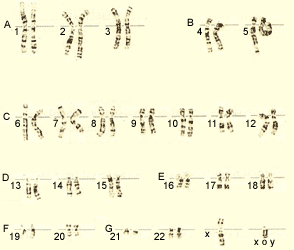
Among the several techniques available, the most frequently used ones are those that are user friendly and low cost. Such techniques allow us to visualize all the chromosomes, in black and white, with a band pattern that permit us to identify each one separately at the same time. These techniques are known as cytogenetic techniques.
Other more newly developed techniques are the so called molecular cytogenetics techniques. There are several types based on their different utilities, being the use of color a common feature in all of them. These techniques include:
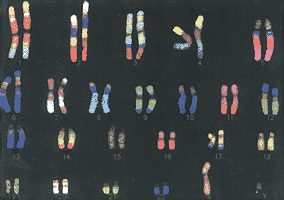
Techniques that allow us to observe all the chromosomes as in the previous photograph, but that have coloured bands instead of black and white ones. These techniques are known as multicolour banding techniques.
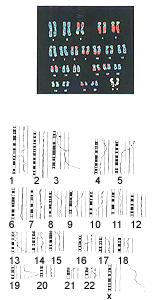
Another technique is comparative genomic hybridization (or CGH), which allows us to see if a chromosome is missing or exceeding a little bit based on the different color patterns that are formed and whose intensity is measured and interpreted by a computer program, compared to a reference sample. There are two varieties of the this technique: conventional CGH and array CGH.
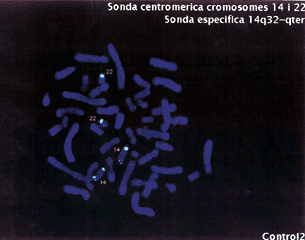
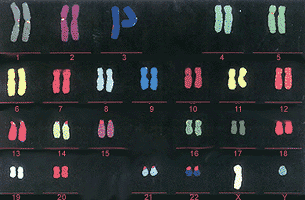
Other techniques are used to see each pair of chromosome in a different color, enabling us to visualize them all at once. This technique, known as SKY or multicolor FISH (Fluorescence In Situ English Hybridization), enables us to diagnose partial or total gains and losses of chromosomes through their color, as well as structural abnormalities involving several chromosomes. The piece that is repeated or unstructured will be of the same color as the chromosome to which it corresponds.

…or just visualise a specific set or sets. For example, in this case, we only want to visualise the pink chromosome.
As you can see these techniques make the study of chromosomes easier, mostly in cases of structural alterations. For example, in cases where a piece of chromosome attaches to a different set.
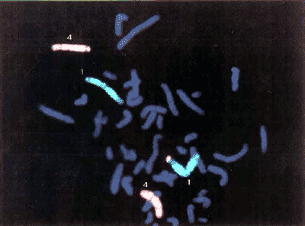
We can see it very clearly! Blue chromosome number 1 has a pink piece stuck to it. If this study is done in black and white we might not notice it, and sometimes it might be very difficult to diagnose.
The physician and the laboratory in charge of the case will decide jointly which techniques should be used. On some occasions, these tests are used as a diagnostic adjunct to conclude the diagnosis.
Another technique is QF-PCR (quantitative fluorescence polymerase chain reaction). This technique allows us, in the case of pregnant women, to rule out the most common chromosomal abnormalities involving chromosomes 13, 18, 21, X, Y. After obtaining cells from chorionic villi, amniotic fluid and fetal blood, without requiring the culture of these samples, the results are obtained after 24 to 72 hours.
- Hospital Universitario Central de Asturias, Biblioteca de Pruebas-Citogenética- Laboratorio de Medicina
- Técnica QF-PCR en Diagnóstico Prenatal y Postnatal
- Diagnóstico prenatal rápido de aberraciones cromosómicas por QF-PCR
Clearly, all these techniques should only be performed in highly specialized centers that require expensive IT support and highly qualified and trained staff for the evaluation and interpretation of these results.
The use of these or other techniques must be based on the doctor´s clinical judgement and the laboratory that is performing the tests, because sometimes these techniques are used as a complement to conclude a diagnosis. For example, in diseases caused by loss or gain of genetic material, very small- sized microalterations cannot be detected by means of standard cytogenetic techniques. All these techniques have their pros and cons, and should therefore be previously evaluated based on what they offer and what we are looking for: diagnostic possibilities, reliability, speed, cost, complementarity, etc.
Mendelian or Mitochondrial disorders
This means the information contained in the genes or recipes inside chromosomes in the nucleus, or the DNA in the mitochondria.
We will use BIOCHEMICAL or MOLECULAR TECHNIQUES for specific diagnosis of these disorders.
Some of these specific diagnostic tests are not available nowadays for some disorders.
There will be two possibilities if this is the case:
- The individual is already born, so he will not have a diagnosis till a specific test is found.
If it is a very serious sickness and the individual might die, a blood sample should be taken, which will be kept frozen for future use, together with a complete medical history, photographs and other specific additional tests. If at some time in the future the couple or other relatives would want to know if they might have more children with the same disorder, and if a specific test is by that time available, the stored blood sample will be used to establish the diagnosis. There is no other option available at this moment. - Or, if on the contrary, the individual has not been born yet, that is during the prenatal period.
If the presenting disorder or pathology is accompanied by some sort of malformation that can be diagnosed through an ultrasound examination, we will use this latter technique to indirectly monitor the anatomy of the baby’s via ultrasound.
Multifactorial disease
That is, there are several factors contributing to its aetiology, both of a genetic (predisposing factors) and environmental nature, the different tests available will be applied in an attempt to establish the origin of the disease, conclude the diagnosis, and at the same, assess the risk as well as the different preventive options available, should a future pregnancy occur.
Environment-related disease
The triggering agent has to be identified and the appropriate measures taken to eliminate it or to avoid it.
If you want to consult specific diseases, these databases can help you.
Remember, that all the information you get, must be interpreted by a specialist before you make any decision. So please have a consultation with a genetics department, where your individual case will be accurately assessed and where your questions will be answered.
Related questions
Next topic: How can all this knowledge be used to our benefit?
Reviewed: 27th of January 2015
